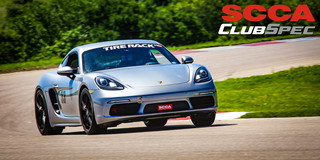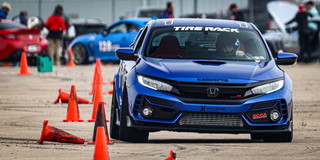
This article first appeared in the October, 2016 edition of SportsCar Magazine. SCCA members can read the current and past editions of SportCar digitally here after logging into their account; To become an SCCA member and get SportsCar mailed to your home address monthly in addition to the digital editions, click here.
Are you training on a racing simulator? Your competition might be.
Every racer knows seat time is critical to success on track. Maybe the most talented drivers can hop into a new car and win, but that’s not the proven path to success. You want experience, both with the car and the track on which you’re going to race. For many SCCA drivers, finding time in their car is not a problem, but getting adequate practice time on a track can be a challenge. With the new tradition of moving the SCCA National Championship Runoffs to a different track each year, the need for practice has become more critical than ever.
If you just needed to know the way around a course, you could get by with one of the many racing games available for popular gaming consoles. Many drivers have used those games to good effect. But if you want to gain a serious advantage over your competition, you need a professional-grade racing simulator that allows you to test changes to your car as well as learn your way around a track.
“Yes, you can use a simulator to learn tracks, but that’s not what it’s all about,” says Keith Maher, owner of Maher Solutions. “Simulation is not driving a car, it’s a tool to help you drive a car better. The difference between a game and a simulation is that a game will give up reality, so it’s enjoyable, while a simulation will predict, with accuracy, what you’re going to do in the real world. If it doesn’t predict with accuracy, then it’s entertainment,” Maher insists.
Maher’s simulator has been developed over time, from a basic seat with several flat screens to a futuristic model that uses Oculus Rift virtual reality goggles to immerse the driver in a realistic model of almost any racing course in the world.
How to use a simulator
T.J. Fischer races formula cars, winning the Formula Mazda SCCA Western Conference Championship in 2013 prior to racing in Europe and then heading back to the U.S. to compete in a Mazda Road to Indy series, and often uses simulator time to sharpen his skills. “Racing simulators are emerging as a necessity more than just a tool,” Fischer says. “It offers a chance to practice day in and day out, working on different techniques, consistency and, more importantly, just seat time for a small fraction of the cost of getting a real car on a real track. The work can be done on our down time and be used as a tool for preparation. There’s no substitute for real world track time, but there certainly is an advantage to functional preparation before we get on track.”
Fischer is coached by Eric Purcell of EFM Racing in Sonoma, Calif. Purcell has installed one of Maher’s simulators in his shop, and offers engineering and driver coaching services there. “We utilize the sim in many different ways depending on what the drivers’ needs are at the time,” Purcell explains. “With the advent of more sophisticated VR hardware, we can now do some substantial driver development on the sim. We can establish proper braking technique, work on the differences between trail braking and trailing throttle – when to use them and the techniques involved – and begin to work on the driver/engineer relationship. All of this was not possible just a couple of years ago.”
Longtime SCCA racer Dominic Dobson is also a veteran of CART, IMSA, Le Mans, the Craftsman Truck Series, and he used simulation to help him win the unlimited division and the Rookie of the Year award at the 2015 Pikes Peak International Hill Climb. One of the challenges of the Pikes Peak event is that drivers are never allowed to practice on the whole course before the actual race. “I did 22 runs up the mountain on the simulator,” Dobson states. “It put me in a place where when I got there I knew the danger spots. I knew where I could go fast, and I knew where to go slow. I didn’t know every apex of every corner, but I really felt like it prepared me well.”
The real world informs the simulator
Every driver interviewed for this story was careful to point out that a simulator is not a complete substitute for real-world testing, but rather a tool that can be used to work on specific tactics and strategies, and for racecar development. In order to create an effective simulation that accurately predicts real-world results, a feedback loop is required.
“We now feed back real data from the actual car to the sim model to keep increasing the accuracy, and this has opened up a whole new window of possibilities to work with the chassis on the sim,” Purcell says. “At this stage, we are still limited to getting basic aero and overall chassis stiffness from the sim, but we have proven these to be very valuable in establishing a starting point for the setup. This continues to improve as we refine our models and we can begin to work with more details of the setup. We can even change the ambient temperature and time of day on some software products and look at the setup differences between morning and afternoon.”
Formula Mazda and Pirelli World Challenge GT3 Cup racer Phil Fogg Jr. agrees, “You can get a general sense for the speed and time tradeoffs with changing rake, wing, ride height, camber, sway bar, and so on. I’m always amazed at how close the simulator lap times are to actual times.”
It’s not perfect – yet
A session on a professional-grade simulator is remarkable. You’ll never forget that you’re on a simulator, but after 20 minutes of driving, you’ll be talking about how the “car” felt or how you approached a turn as if you’d been in the real world.
Few drivers have more professional and Club Racing experience than Cindi Lux. She approaches any simulator cautiously. “When racing, there are consequences for your actions on track,” Lux says. “But in a sim, you just go off, learn from it, and then hit the reset button, so you need be careful not to train your brain that this is acceptable. In real life, if you damage a car, you miss a session, which hurts the team. Then there are the costs of the repairs, which hits your wallet.”
Former MX-5 Cup champion and current pro driver Kenton Koch observes, “There’s no reset button in a real car. So you have to drive it like you would a real car in real life to get the most out of it.”
Expanding availability
Right now there are only a few accessible professional-grade simulators available. CXC Simulations has a facility in Los Angeles, and Maher’s simulators are available in Portland, Ore., and Sonoma, Calif. In Canada, VRX Simulators has a facility in Victoria, British Columbia.
“Right now we’re really at a sweet spot where the software is constantly evolving, the hardware is really improved, and now we’ve got virtual reality – I’m focused on helping drivers win races,” Maher says.
To help more drivers win their races, Maher is hoping to expand the availability of his simulators. In the near term, however, most drivers must still travel for simulator time. As drivers prepare for the Runoffs and other end-of-season events, simulator time could make a difference in how those seasons end.
Words by: Jeff Zurschmeide
Image courtesy of: CXC Simulations










